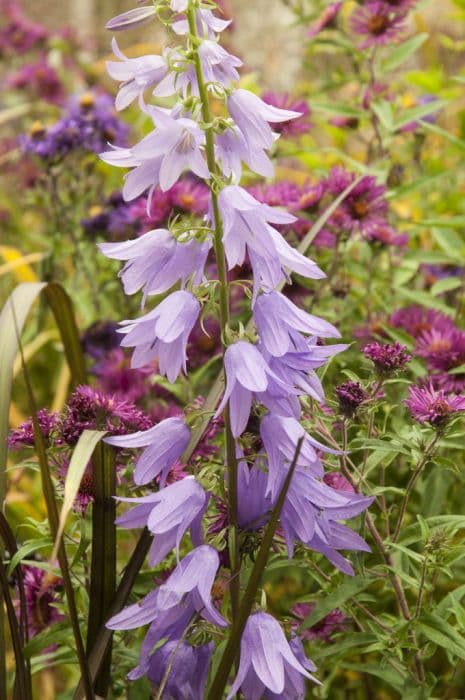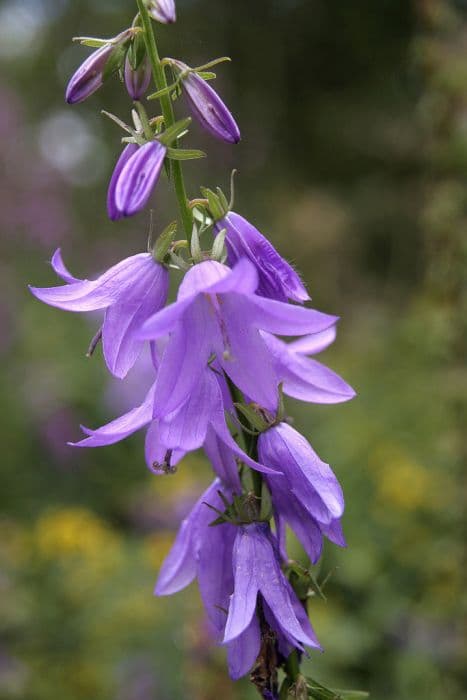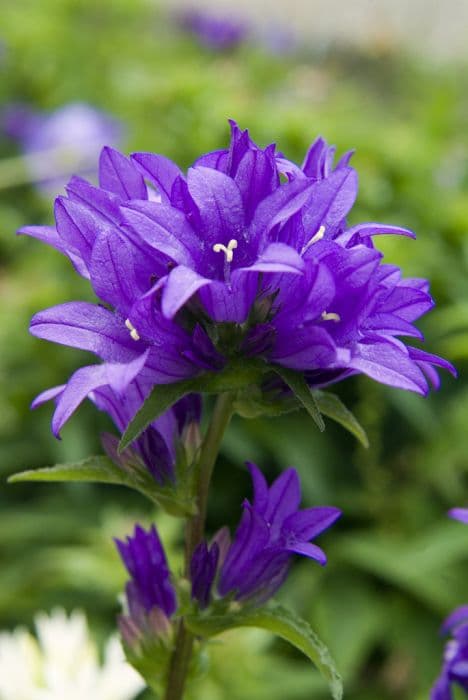Korean Bellflower Campanula takesimana

ABOUT
The plant commonly known as Korean bellflower has a notable appearance characterized by its lush foliage and striking flowers. The leaves of this perennial plant are bright green, broadly lance-shaped, and have a toothed edge, offering a hearty and full backdrop for its blooms. It's the flowers, however, that capture most of the attention. They hang gracefully in clusters from the stems and have an elegant bell-like shape, reminiscent of the skirts of tiny ballerinas. These blossoms boast a soft pale lavender or sometimes a white hue, with conspicuous deep purple spots and streaks that decorate their insides. The fusion of these colors creates a charming speckled effect that is quite eye-catching. The overall aspect of this plant is one of delicate beauty and classic garden charm, making it a popular choice for many gardeners looking to add a touch of whimsy to their floral arrangements.
About this plant
 Names
NamesSynonyms
Korean Bellflower, Island Bellflower, Creeping Bellflower
Common names
Campanula punctata var. takesimana, Campanula takesimana var. albiflora, Campanula takesimana var. hondoensis.
 Toxicity
ToxicityTo humans
The Campanula takesimana, commonly known as Korean bellflower, is not typically considered toxic to humans. There are no well-documented reports of toxic effects from ingesting this plant. However, as with any plant, individual allergic reactions or sensitivities could occur.
To pets
The Korean bellflower is not widely known to be toxic to pets such as dogs and cats. No specific toxic symptoms have been reported from pets ingesting this plant. Nonetheless, pet owners should still be cautious and prevent their pets from consuming non-food plants as they can cause gastrointestinal upset or an allergic reaction in sensitive animals.
 Characteristics
CharacteristicsLife cycle
Perennials
Foliage type
Deciduous
Color of leaves
Green
Flower color
Pink
Height
2 feet (60 cm)
Spread
2 feet (60 cm)
Plant type
Herb
Hardiness zones
3
Native area
Korea
Benefits
 General Benefits
General Benefits- Aesthetic Appeal: Campanula takesimana, commonly known as Korean bellflower, offers beautiful bell-shaped flowers that enhance the visual appeal of gardens and landscapes.
- Pollinator Friendly: The flowers attract pollinators like bees and butterflies, supporting biodiversity in the garden.
- Versatility in Landscaping: It can be used in various garden settings, including rock gardens, borders, and as ground cover.
- Low Maintenance: Korean bellflower requires minimal care once established, making it a convenient choice for gardeners of all skill levels.
- Drought Tolerance: It is relatively drought-tolerant, reducing the need for frequent watering.
 Medical Properties
Medical Properties- Anti-inflammatory properties: Campanula takesimana may contain compounds that can help reduce inflammation.
- Wound healing: It is believed to have wound-healing abilities due to its potential antiseptic properties.
- Antioxidant action: The plant may contain antioxidants which help in protection against cellular damage.
 Air-purifying Qualities
Air-purifying QualitiesThis plant is not specifically known for air purifying qualities.
 Other Uses
Other Uses- Groundcover: Campanula takesimana, commonly known as Korean bellflower, can spread quickly under favorable conditions, making it suitable for use as a groundcover to prevent soil erosion and suppress weed growth.
- Education: Korean bellflower can be used in educational gardens or programs to teach about pollination, as it attracts bees and other pollinators.
- Garden Borders: Due to its lush foliage and attractive flowers, Korean bellflower can be planted along borders for a decorative edge in cottage gardens or traditional garden landscapes.
- Rock Gardens: The Korean bellflower's ability to adapt to various soils makes it an excellent addition to rock gardens, where its flowers can add color contrast against the stones.
- Wildlife Habitat: Korean bellflower provides nectar for insects and can be included in wildlife gardens designed to support local ecosystems.
- Photography: The striking blooms of Korean bellflower can be a subject for garden photography, capturing the essence of a flourishing garden.
- Floral Arrangements: The flowers of Korean bellflower can be cut and used in fresh floral arrangements, adding a touch of elegance to bouquets and indoor settings.
- Garden Themes: Korean bellflower can be used in thematic gardens, such as fairy or magic-themed spaces, due to its enchanting bell-shaped flowers.
- Container Gardening: This plant is well-suited for container gardening where ground space may be limited, offering vertical interest and cascading blooms.
- Vegetable Garden Companion: The Korean bellflower can be planted near vegetable beds to attract beneficial insects that may help with pest control.
Interesting Facts
 Feng Shui
Feng ShuiThe plant Korean bellflower is not used in Feng Shui practice.
 Zodiac Sign Compitability
Zodiac Sign CompitabilityThe plant Korean bellflower is not used in astrology practice.
 Plant Symbolism
Plant Symbolism- Perseverance: The plant's ability to grow in rocky and challenging terrains symbolizes enduring through difficult circumstances.
- Constancy and fidelity: The bell-shaped flowers, often associated with constancy, are symbolic of steadfast loyalty, often in love and relationships.
- Gratitude: They can express thanks for a kind action or support received, as their blooms are seen as a gift of nature's beauty.
- Hope: The blooms opening like bells are reminiscent of the act of looking upward, which can symbolize hope and looking towards the future.
 Water
WaterKorean bellflower ideally should be watered regularly to maintain moist but not waterlogged soil. During the growing season, it may need watering once or twice a week depending on weather conditions. It is best to check the top inch of soil; if it feels dry, it's time to water. Apply water slowly at the base of the plant until it begins to run through the drainage holes, which might mean one to two gallons for an outdoor plant or several ounces for a smaller, indoor pot.
 Light
LightKorean bellflower thrives in partial shade to full sunlight. The optimal spot provides morning sunlight and protection from the harsh afternoon sun, which could scorch the leaves. If grown indoors, placing the plant near a window with bright, indirect light would be ideal.
 Temperature
TemperatureKorean bellflower prefers moderate temperatures and can generally tolerate a temperature range from approximately 40 to 85 degrees Fahrenheit. It will thrive best in temperatures that hover around the 60 to 70 degrees Fahrenheit range. Protect the plant from extreme cold, which could damage it, and avoid placing it in locations where temperatures may drop below freezing.
 Pruning
PruningPruning Korean bellflower encourages bushier growth and helps to maintain its shape. Deadheading, or the removal of spent flowers, will promote more blooms. It's best to prune or deadhead the plant after a flush of blooms has faded, which may occur several times during the growing season. Pruning can also involve cutting back the plant in late fall to prepare it for winter.
 Cleaning
CleaningAs needed
 Soil
SoilThe best soil mix for Korean Bellflower (Campanula takesimana) should be rich, well-draining, and loamy with a pH of 6.0 to 7.5. You can create a suitable mix using equal parts of garden soil, peat moss, and perlite to ensure good drainage and fertility.
 Repotting
RepottingKorean Bellflower (Campanula takesimana) should typically be repotted every 2 to 3 years to refresh the soil and allow room for growth. Spring is the best time to repot this plant to minimize stress and promote recovery.
 Humidity & Misting
Humidity & MistingKorean Bellflower (Campanula takesimana) thrives best at average room humidity levels between 40% and 60%. They do not require high humidity and can adapt well to indoor conditions.
 Suitable locations
Suitable locationsIndoor
Keep the Korean Bellflower in bright, indirect light and well-draining soil.
Outdoor
Plant Korean Bellflower in partial shade and moist, well-draining soil.
Hardiness zone
3-8 USDA
 Life cycle
Life cycleCampanula takesimana, commonly known as Korean bellflower, begins its life cycle from seed germination, which typically occurs in cool temperatures of spring or autumn. The plant develops a rosette of basal leaves and establishes a strong root system in its juvenile phase. As it matures, the Korean bellflower sends up flowering stalks during late spring to early summer, with bell-shaped, nodding flowers that are typically pink or lavender. After pollination, often via bees or other insects, the flowers produce seeds, which are dispersed by wind or gravity. If conditions are favorable, these seeds can germinate to start a new life cycle, while the parent plant may die back during winter, only to regrow from its perennial rootstock in the following spring. If conditions are harsh or unfavorable, the plant can enter a period of dormancy until suitable growth conditions return.
 Propogation
PropogationPropogation time
Spring-Early Summer
Korean bellflower, or Campanula takesimana, can be propagated through division, which is typically done in either the spring or early fall. This method involves carefully digging up an established plant and gently separating the root ball into smaller sections, each with a portion of the root system and some shoots. These divisions should be replanted promptly in well-draining soil at the same depth they were originally growing and watered thoroughly. Dividing the plant every few years also helps to maintain vigor and prevent the center of the plant from dying out. This process rejuvenates the plant and increases the number of plants in your garden without needing to buy new ones.









